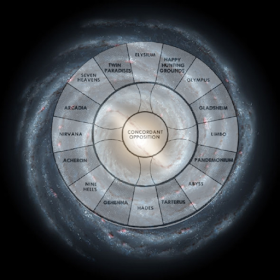While we have one more session of our Land of Azurth campaign before the end of the year, it's a good time to look back at what the "Masters of Mayhem" (as the party calls themselves) got up to in year six, game sessions 53-69.
The Vault Job
The party returned from a trip to a dark future to find the Clockwork Princess of Yanth Country in seclusion, and Drumpf the new, authoritarian mayor of Rivertown. The lure of gold convinces the party to help the former mayor Gladhand liberate some of this gold, currently being held in the vault of Sly Took, member of the Raccoon Thieves Guild and banker to the underworld. The party hatched an elaborate scheme involved a magical armoire and succeed in getting Gladhand's gold.
With the heat on, and wanting to talk with the Queen of Virid about events in the future anyway, the party headed out on the road.
Servants of Shadow
Near the northern border Yanth Country, they party stopped to help a village of cervid centaur folk who are being menaced by a bickering couple of Umbral drakes who emerged from a shadowy vortex within an ancient ritual circle. The party kills the drakes, but it turns out they are only the first incursion of agents of Umbra, the Shadow Moon. A group of
Gloom Elves are inhabiting a half-dilapidated tower.
Uncharacteristically, the party winds up reaching a compromise with the elves. They hold a cryptic conversation with a vaguely familiar shadow man who steps through a door opened by the elves.
Shkizz
Further down the road, they decide to spend the night in the town of Shkizz. They discover the townsfolk are priggish and uptight in the day, but wild libertines at night. The discover a cult worshipping a pig demon, but it turns out he is only taking advantage of the situation, not its cause. He blames it on the High Priest of the Church of the Dark Flower in the neighboring Duchy of Dhoon.
Slekt Zaad
The party finds Dhoon suffering under a series of nonsensical decrees of from the Duke, who no one has seen in some time. The party confronts Zaad who reveals himself as some sort of plant being. He also reveals he's allied with the captain of the Ducal guard and they have the Duke ensorcelled. After busting out of jail, the party makes there way to an ancient fane hidden by kudzu, where discover Zaad's magical botanical laboratories--and they recover the gem that holds Zaad's soul. With that gem, they defeat him and lift the curse on the Duke.
The Demon Barber of the Sapphire City
Finally, the party arrives in the Sapphire City and become intrigued by a series of disappearances and mysterious, magical tonsorial makeovers. It turns out to involve dopplegangers of magic hair and the machinations of a hag and her adoring humanoid tribe.
The party is reunited with their old comrade Calico Jack who was being held captive beneath the barber shop.
A Famine in Ffalgo
As word of their deed spreads, two teens from the village of Ffalgo on the Sang border seek out the party to request their help in journeying to an ancient castle in Sang, said the magical produce an endless supply of chicken...


















































